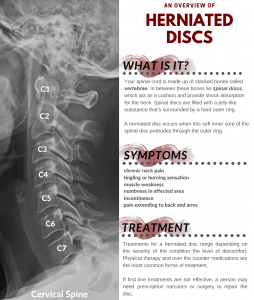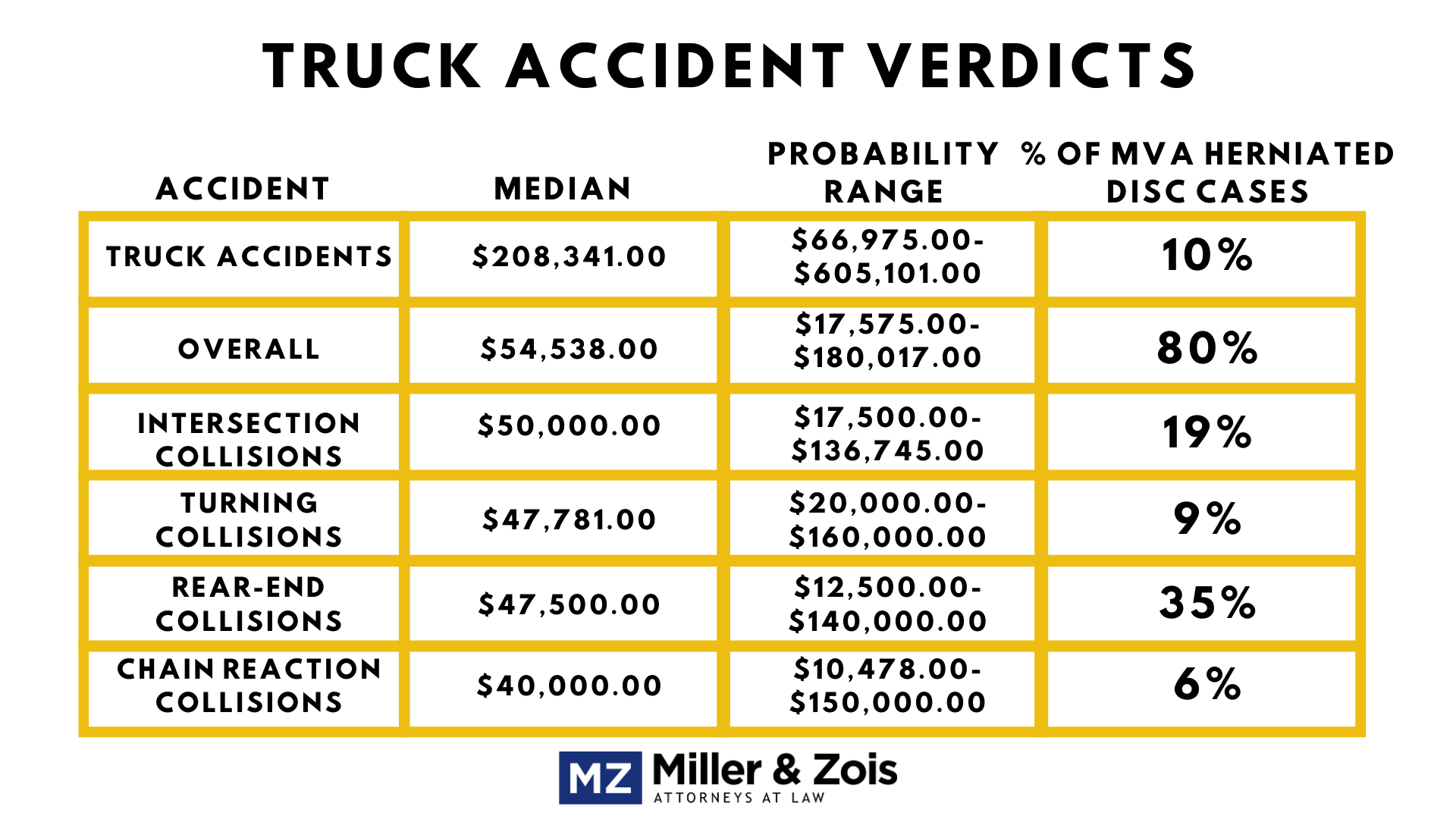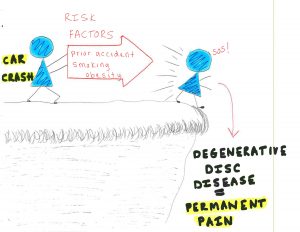The first case I tried for Miller & Zois 18 years ago was a herniated disc injury. I remember it like it was yesterday. It was a car/light truck crash. We got a $300,000 verdict in a case with a $15,000 settlement offer. The defense lawyer thought it was a nuisance case because there was no visible property damage. The jury set him straight.
Since then, our lawyers have handled hundreds of slipped disc injury accident claims for victims. If another plaintiffs’ law firm has handled more herniated disc injury lawsuits in Maryland, I’d like to know who that is. Our lawyers have spent a lot of time fine-tuning the science and the arguments to make at trial in these spinal injury cases.
I have always been particularly interested in verdict statistics in disc injury claims. Yesterday, I found some interesting data that looks at the median value of herniated disc injury claims based on the type of vehicle crash. The data provides two things: the median result and a probability range of verdict.
Of the two, I think the most interesting is the probability range. In this Jury Verdict Research Study, the probability range is defined as the middle 50 percent of all awards arranged in ascending order in a sampling, 25% above and 25% below the median. In other words, it provides the 25th percentile and the 75th percentile of verdicts. I believe that for plaintiffs with a good law firm who knows how to prepare and try a disc injury lawsuit, I think the 75th percentile is probably the median.
Anyway, these are the numbers:
The first thing that really stands out is the gap in the range, which is particularly pronounced as you might expect in truck accident crashes. I’m also surprised at how relatively low the statistics are for intersection accidents.
They are all motor vehicle accidents. What surprises me is how much more the value of herniated disc injuries explodes when taken outside of the motor tort context. Look at these payouts by type of tort claim:
| Premise Liability | $219,410 | $75,000 – $755,574 | 32% |
| Overall | $196,051 | $62,400 – $750,000 | 20% |
| Business Negligence | $181,629 | $51,177 – $688,000 | 59% |
Sure, you will have some serious injury business negligence and premises liability type cases. But you would think garden variety slip and falls would pull those numbers down. It makes little sense that a premises liability herniated disc claim would get more money than a herniated disc caused by a truck crash.
Many people come here looking for a herniated disc settlement calculator, hoping to punch the numbers into a formula and it spits out the value. Using statistics and example stories of settlement and verdicts will get you a lot closer to understanding the potential value of your case than a silly calculator.
What Is a Herniated Disc?
Your discs are the spine’s shock absorbers. These soft, gel-filled discs prevent contact and pressure on the vertebrae in your spinal column.
You have a herniated or slipped disc when you have a migration of the center portion of the disc that causes a protrusion outside of the spinal column. A protrusion is a subcategory of herniated discs. So all protrusions are herniated discs, but not all spinal herniations are protrusions. Disc injuries without protrusions usually cause less neck and back pain. Sometimes they have no discomfort and are entirely asymptomatic.
Medical definitions are hard to understand. Think of it this way. There is an inner nucleus, which is kind of like the pulp in an orange. The outer skin keeps it all together, much like the skin of an orange. If you crush the orange, the skin on the orange will split. Pulp from inside the orange would come out. The protrusion of the pulp is the herniation. The protrusion may hit a nerve from the spinal cord. If it does, you are likely to feel a shooting pain or experience numbness or weakness. Our attorneys have seen cases where the disk compresses the nerves that control the bowel and bladder, leading to a loss of bowel control.
How the patient got a herniated disc is often a battle in litigation. A herniated disc may occur traumatically from a single traumatic event (which is good for the plaintiff) or it may occur over a long period due to repetitive subtraumatic motion (which is good for the defendant). You can also have both, right? This is a new acute herniation superimposed on a degenerative herniated disc. Defense lawyers refuse to believe this happens. But science says otherwise.
What Are the Real Keys to the Settlement Value of Herniated Disc Injury Case?
The type of accident is important. But that does not drive the value of personal injury cases. The biggest issue in a herniated disc injury claim – bar none – is whether there was preexisting symptomatology. Does that mean you can’t win if you had a preexisting condition? Absolutely not. But it means the hill will be steeper to climb. The chance of your case going to trial is also much higher.
The second big driver is whether the disc injury is the exacerbation of a preexisting condition. What does this mean? Many people have dormant disc injuries where they have no symptoms until a trauma like a fall or an automobile collision. When you see words on an MRI report like spondylosis, spinal degeneration or degenerative osteoarthritis, you know that you have a preexisting condition. This is true even if you had no symptoms. People get very frustrated when they hear this because they “know” they were fine before the crash.
Keep in mind we are talking third-party insurance claims for neck and back disc injury cases. The settlement numbers in workers’ comp cases will be much lower.
In this video, I explain in specific detail all the key factors in how herniated disc injury cases are valued for settlement.
Pre-Existing Injury Cases
As I explain in this video, acute disc injury cases are a lot easier to win (and settle) than claims for victims who had preexisting injuries. Defense lawyers fight these relatively hard before offering a good settlement value, particularly if the victim did not get immediate medical attention after the crash. We file more of these cases than we settle pre-suit. Another point worth underscoring in these cases is that while the plaintiff’s credibility is essential in every personal injury case, the plaintiff’s performance at a deposition is an even more critical event. Why? Because whether the client with signs of degenerative changes (often a bulging or ruptured disc) has suffered a serious injury in the collision will rest to a great degree on whether the insurer and ultimately the jury, believe the story.
Again, to be clear, this is hardly an impossible task. The wind in these cases is usually to our backs if there is no significant evidence in the medical records or in the testimony that the victim had serious problems before the accident. But you still need to jump over the “oh, this would have happened to your S1 disc anyway because of genetics, lifestyle and age” hurdle the insurance companies will put at your feet. How do you do this?
In 95% of the cases we take to trial with this issue, we need the patient’s treating doctors to stand behind the patient and thin slice the difference between where the patient would have been before the accident and where the patient is now.
This is how you have to explain a preexisting injury case to a jury:
You can’t find that the victim was more susceptible to injury than someone else. You must convince the jury that this person could have lived pain and symptom-free on that cliff. But the defendant made a choice that pushed her off the cliff to a future of pain.
Medical Literature
- Fjeld OR, et. al (2019): Complications, reoperations, readmissions, and length of hospital stay in 34,639 surgical cases of lumbar disc herniation. Bone Joint J. 2019;101-B(4):470–477. Sometimes, the trial or settlement value of a herniated disc injury involves future disc surgery Most surgeries in the lumbar spine are diskectomies. If all goes well, a discectomy involves removing the displaced disc (the pulp from the orange to use the example above). You also hope to decompress the neural structures to relieve pain. Finally, a successful discectomy will limit the risk of recurrence by clearing out any disc material in the intervertebral space and the surrounding area. The success rate for this surgery is high, as this article points out, but it comes with the risk of real complications, including, in rare cases, death. So many patients choose physical therapy or epidural steroid injections. The risks of a bad outcome like a spinal cord injury or death are very real.
- Kreiner DS, et al (2014). An evidence-based clinical guideline for the diagnosis and treatment of lumbar disc herniation with radiculopathy. Spine J. 2014;14(1):180–191.2. The goal of this paper, written by 24 doctors, is to offer updated recommendations dealing with key clinical questions on the diagnosis and treatment of disc herniations in the back that impinge on a spinal nerve root. Experts on both sides of the aisle sometimes refer to these guidelines in litigation.
More Information
- The Value of Herniated Disc Claims (settlements and trial statistics)
- More Average Verdict Data
- Examples of Herniated Disc Injury Settlements
- How Much Money Should I Ask for in My Settlement?
- Video that drills down on how car accident cases are valued for settlement in Maryland
Getting a Lawyer for Your Claim
I do not think our law firm’s experience in handling these claims is matched, at least not in Maryland. We really are herniated disc injury lawyers. Our attorneys know the science, medicine, and experts in these cases. If you have a potential claim, give me or any of our personal injury lawyers a call at 800-553-8082 or get a free online consultation here.
 Maryland Injury Law Center
Maryland Injury Law Center




